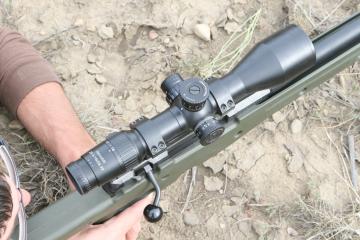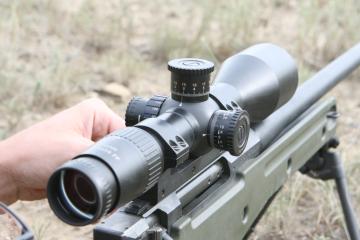
 # 1. # 1. Like many European scopes, the elevation dial turns clockwise for "up" and has click values
in 0.1 mil.
The Hensoldt 4-16x56 mm lacks one of the distinguishing features desired in a scope for practical
long-range shooting: the zero stop elevation knob. Zero-stop elevation knobs can be set to prevent
dialing the knob "below" the primary zero (usually 100 yards), or at least prevent dialing more than
a couple clicks below zero. This feature is useful because it allows the shooter a way to
physically verify the elevation knob is dialed all the way down and to not get confused which
revolution it's on. However, with the Hensoldt mounted on a 28-moa base, its elevation knob was
about 6 mils up from being bottomed out. Thus, it was still easy to make sure the knob was on its
"zero revolution" by dialing it down until it stopped and then dialing it back up to the zero mark,
about 60 clicks. However, if I had to be able to dial down to my true zero by only touch and
without visual confirmation, the 4-16x56 mm would make this task harder than a scope with a true
zero stop like the Premier Heritage, S&B PMII, US Optics SN-3, and some Nightforce and Leupold
models.
During testing, I shot the 4-16x56 mm Hensoldt on the 7mm Remington Magnum Accuracy International
rifle at a variety of 0.5 - 2 moa steel targets from 100 to 1350 yards. The scope simply worked
with no drama. I did have a chance to shoot at an approximately three-foot diameter steel plate at
1850 yards; however, six mils of elevation taken up under the scope's zero, I ran out of elevation
before I could get the bullets on-target. With the six mil zero offset, I was limited to dialing
about 18 mils elevation. I needed a little bit more, so I just used reticle-based holdover in
addition to dialing as much as I could with the knob.

 # 2. # 2. The advantage of mil-based clicks (0.1 mil per click) is that the units of the
knobs match the units of the mil-dot reticle.
Over the last year, I've also done evaluations of the latest S&B, USO, and Premier scopes. Here's
how the Hensoldt stacks up in those three areas outlined above. First, all of them were correctly
calibrated: their knob clicks moved the point of impact (POI) the correct amount, and their reticles
demarcated the right amount.
The second evaluation - qualitative comparison of scope features - offers more differences. All
four offer FFP reticles. The USO's "EREK" elevation knob has user-adjustable zero stop; it can be
configured a variable amount away from the true zero. The S&B and Premier both have true zero
stops. The Hensoldt 4-16x56 mm does not have a zero stop. All of the scopes have what I term a
big, many-click knob, allowing the shooter to get to 1000 yards in less than one full turn. The
S&B and Premier scopes have optics or physical flags that indicate when the elevation knob is on the
second turn. The USO SN-3 and the Hensoldt rely on conventional hash marks on the turret body to
indicate the knob revolution. In comparison, the Hensoldt lacks two qualitative features offered
on other high-end scopes for practical long-range shooting.
|